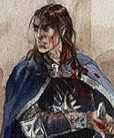Tolkien and the Edda

As we all know, Tolkien’s works were partly inspired by different mythologies, especially the Norse. He learned languages like Finnish and Icelandic to be able to read the sagas in their original languages, even having an Icelandic maid who helped him learn Icelandic, and he used much of the contents of the Norse sagas in creating his own world of mythology.
One of his main sources was the Icelandic Edda. The Edda consists of two parts, the Song-Edda which is a compilation of ancient songs and poems about heroes and gods, and the Prose-Edda or Snorra Edda which contains stories about the gods.
While the Song-Edda is very hard to read and to understand because it is written in poetry only, the Snorra Edda is much easier. The stories about the Norse gods like Thor, Odin or Tyr are interesting, sometimes even funny, and always easy to understand.
The point of the Prose-Edda was not to save the old stories from being forgotten, but to teach the art of poetry to the “skalds”, the Norse poets. It was written around 1220 A.D. by Snorri Sturluson, an Icelandic skald and judge, who collected these stories and used them as an example of “good poetry”. Nowadays, however, it is an important source for everyone interested in the Norse mythology since it contains their most important stories.
Tolkien used motives from the Edda to develop his world. One striking aspect is the resemblance of certain names. When I first read the Edda, I was very surprised to hear of Dwarves that were called Dvalinn, Bifur, Bafur, Bombur, Óri, Nori, Þrór, Þróinn or Glóinn and many other names we know from ‘The Hobbit’ and ‘The Lord of the Rings’. Even the name Gandálfr appears – as a dwarf. Another name which appears in the Edda is Alföður, the Norse god who created the world out of Ginnungagap, the “absolute nothing”. His name means “all-father”, just like Ilúvatar in Tolkien’s world. Like Ilúvatar, Alföður is the highest of the gods who created the earth and everything that dwells on it. Another resemblance is of course the name Middle-earth which is the translation of the word “Midgard”, the world of Men and Elves.
Several creatures in Tolkien’s works are also inspired by Norse myths. An example of this is the Nazgûl, who resemble the original notion of the Valkyries. The Valkyries were not always Odin’s “warrior maids” that chose dead fighters to dwell in Valhall, where they would fight all day and return in the evenings with all their wounds healed to eat and drink all night, but they were orginally cruel and bloodthirsty demons who rode on bat-like dragons or horses, just like the Ringwraiths.
A character who has his equivalents in many mythologies is Gandalf. In Norse mythology, the man that dies but returns from the dead is Baldur, the god of beauty. He was killed by the wicked god Loki and went to Hel, the realm of the dead that do not go to Valhall. After his death, no pure beauty and happiness was left on the earth. After Ragnarök, the last battle against the giants which proved the end of the Norse gods, Baldur returned to the new earth together with the few other gods that had survived. This resurrection image also fits the line of the Kings of Númenor and later of Gondor. When the line was broken, Gondor became weaker and weaker until it was finally close to destruction when Aragorn returned as King in Third Age 3019.
Even the One Ring, the central topic in ‘The Lord of the Rings’, has its roots in Norse mythology. The Edda tells of the Norse god Loki who met a dwarf called Andvari and forced him to give him all his great treasures, among which was a magical ring that was able to produce gold. But in his rage, Andvari put a curse on the ring that should ruin every bearer. Like the One Ring, it caused great trouble and every one of its bearers was killed in some way. It caused the maiden Brynhild to kill herself when her lover Sigurd gave her the ring as a gift, and it also caused Fafnir to slay his own father Hreidmar in greed to protect his treasure. Later Fafnir used the ring’s power to turn himself into a dragon to guard this treasure and was killed by Sigurd.
These are just a few examples of Tolkien’s use of the Icelandic myths and sagas. They show not only his love and interest for these old stories, but also the work he put into developing his world in order to make it seem so thoroughly complete and well thought out.
by Sindaeririel









